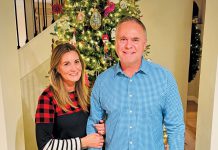A stroke occurs when the blood supply to the brain is suddenly altered. This can occur when a clot in a blood vessel blocks blood flow to brain tissue, or when a burst blood vessel causes a part of the brain to drown in its own blood. These conditions cause brain cells to die or at least become damaged, which can cause temporary or permanent changes in body and mind function. Every year, 800,000 Americans have a stroke.
A transient ischemic attack, also called a mini stroke, is a temporary stroke-like condition that usually resolves in a number of hours. TIAs are often a warning of a future, more serious stroke.
These are some risk factors for a stroke:
– Age: Most strokes occur in older adults, but as many as a quarter of them strike people younger than 65.
– Family history: This is especially true if a sibling or a parent has had a stroke.
– Gender: Men have strokes more than women. Pregnant women are at risk, however.
– High blood pressure, increased cholesterol, and smoking
– Diabetes
– Heart disease, especially atrial fibrillation
Signs and symptoms of a stroke include numbness or weakness of one side of the face, arm or leg; sudden difficulty speaking, remembering, or thinking; trouble with vision or swallowing; sudden difficulty walking or balancing; and sudden severe headache.
There is a clot-busting medication that can stop most strokes in their tracks if given promptly enough. Guidelines call for this drug to be given within 4½ hours of the very first sign of a stroke. Dominican Hospital here in Santa Cruz has this treatment available.
If you, a loved one or friend is having a stroke, do not go to your doctor’s office or to an urgent-care clinic. Call 911 and be taken by ambulance to the hospital. Research shows that people who arrive at the hospital by ambulance get there faster, get seen faster and are more likely to get necessary treatment in time to prevent permanent brain damage. Do not hesitate or delay. Don’t worry about a “false alarm.” Better safe than sorry.
If you think someone is having a stroke, the National Stroke Association recommends the F.A.S.T. test:
– “F” stands for face. Ask the affected person to smile. Does one side of the face droop?
– “A” stands for arm. Ask the person to raise both arms. Does one drift downward?
– “S” stands for speech. Is speech slurred?
– “T” stands for time. Call 911. Get the person to hospital ASAP.
– Terry Hollenbeck, M.D., is an urgent-care physician at Palo Alto Medical Foundation Santa Cruz in Scotts Valley. Readers can view his previous columns on his website, valleydoctor.wordpress.com, or email him at va**********@*******al.net. Information in this column is not intended to replace advice from your own health care professional. For any medical concern, consult your own doctor.











